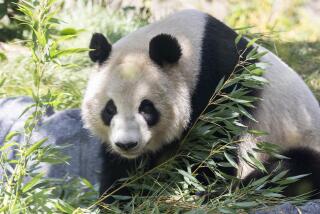SANTA ANA : This Baby Has World by the Tail
- Share via
Two-year-old Stephen Crane hung on the chain-link fence that separates the public from the monkey cages at the Santa Ana Zoo on Thursday morning.
The youngster ignored all of the activity around him as he concentrated on a cage filled muscular Capuchin monkeys who were busy scurrying around their living area with reckless abandon.
“We sure have a lot of fun watching them,” said the youngster’s father, Jim Crane. “They are just so animated and active.”
But the biggest reason why this group of brown South American monkeys has been attracting so much attention at the zoo this month is the birth of a baby Capuchin on Oct. 3.
The tiny monkey, whose sex has not yet been determined, has been busy winning the hearts of zoo patrons, many of whom had never seen a baby monkey before.
“I could just spend hours here,” said visitor Rosalva Van Buskirk, who smiled as she watched the newborn cling firmly to its mother’s neck. “It’s just amazing how well the baby holds on.”
The public’s interest in the baby Capuchin--a type of monkey characterized by a nearly bare face and a hood-like crown of light silver hair--isn’t too surprising to zoo officials.
“There are a lot of reasons why people are so fascinated by primates,” said Connie Sweet, the zoo’s animal curator. “I think the biggest reason is because they are so much like we are, or like we wish we could be.”
The curious and active Capuchin monkeys are characteristically small and normally live in the tallest trees in South American rain forests. They got their names because their heads resemble the hoods worn by Capuchin monks.
“They’re as good with their feet as they are with their hands,” Sweet said. “They are also really handy with their tails. They can grasp onto things with it and hold onto them. It’s kind of like having a fifth hand.”
The addition of the baby Capuchin brings the zoo’s primate population to 54. The small zoo has a relatively large collection of primates because benefactor J.E. Prentice stipulated that the zoo always maintain at least 50 monkeys when he donated land for the facility in 1952.
The primate collection will be getting yet another addition “any day now,” Sweet said--a second Capuchin monkey is scheduled to give birth.
The infants will stay with their mothers for at least a year before the zoo attempts to relocate them. Both mothers became pregnant between birth-control implants. Nearly 50% of the zoo’s mammals in potential breeding situations are on some form of birth control, zoo director Claudia Collier said.
“We are trying to do the responsible thing by implanting the animals, but we were a little late this time with our mother Capuchins,” Collier explained.
Although the baby Capuchin is still nursing, eventually it will be fed the same diet as the older monkeys--yams, peanuts, bananas, lettuce, spinach, watermelon, corn and Monkey Chow, a specially formulated biscuit.
Earlier this year, the City Council unanimously approved a 10-year, $10-million expansion plan for the zoo, including construction of a 34,000-square-foot primate exhibit which will be home to black howling monkeys and capybaras, 100-pound members of the rodent family.
The zoo, which is maintained and operated by the city, was built in the 1950s and attracted 240,000 visitors last year. It is open daily from 10 a.m. to 5 p.m. and is at 1801 E. Chestnut Ave., one block south of 1st Street and the Santa Ana Freeway.
More to Read
Sign up for Essential California
The most important California stories and recommendations in your inbox every morning.
You may occasionally receive promotional content from the Los Angeles Times.










